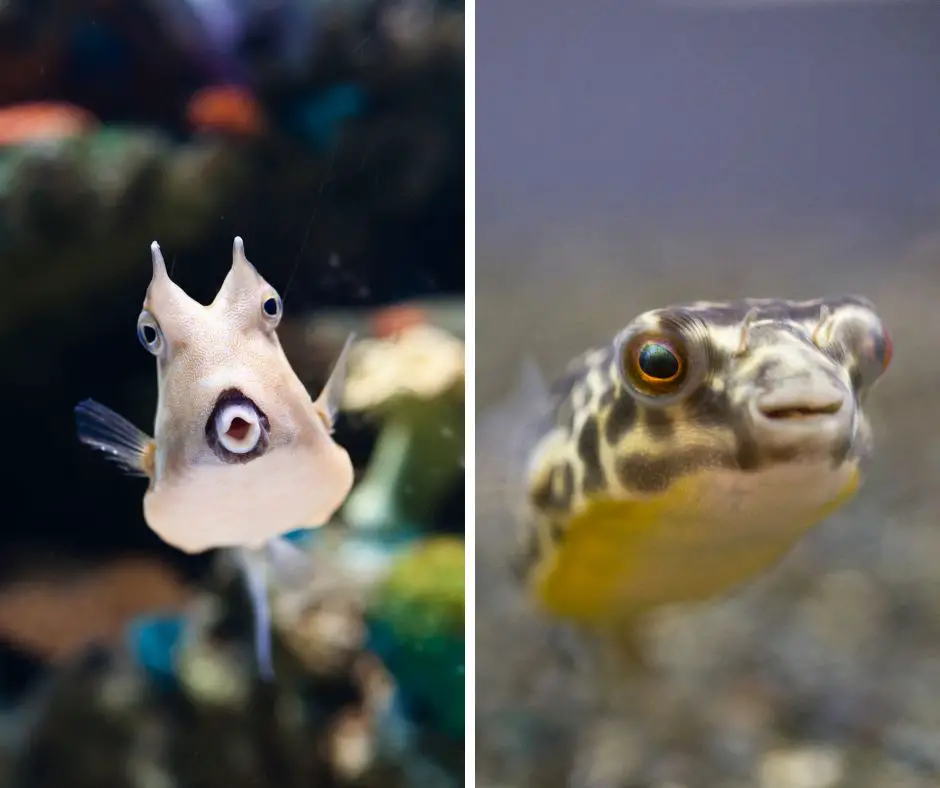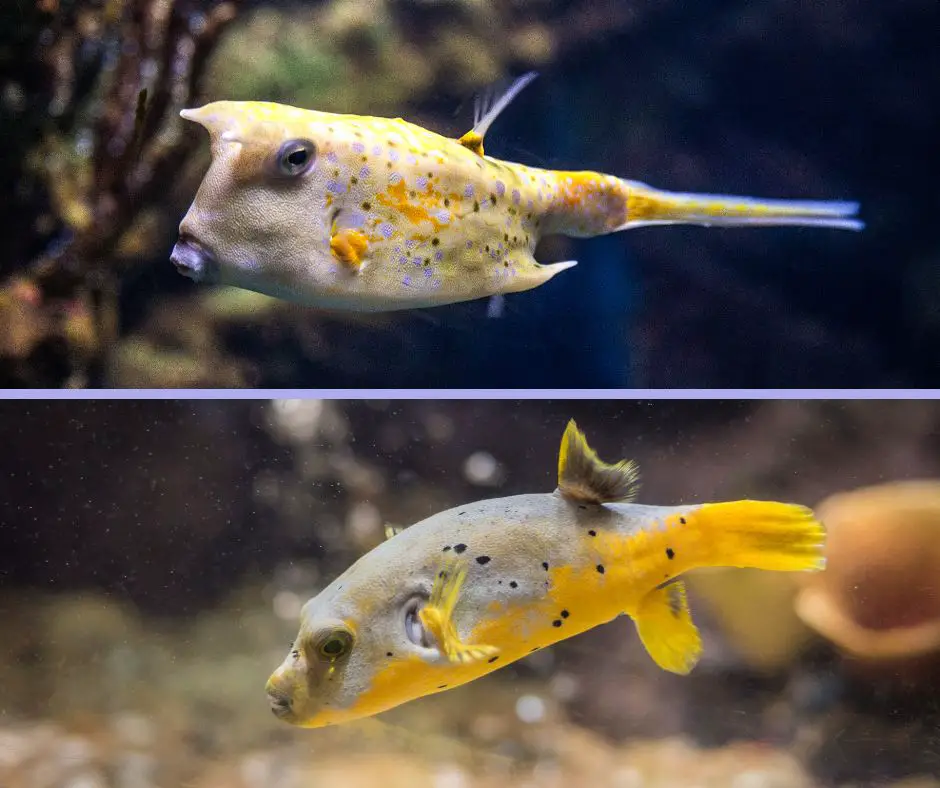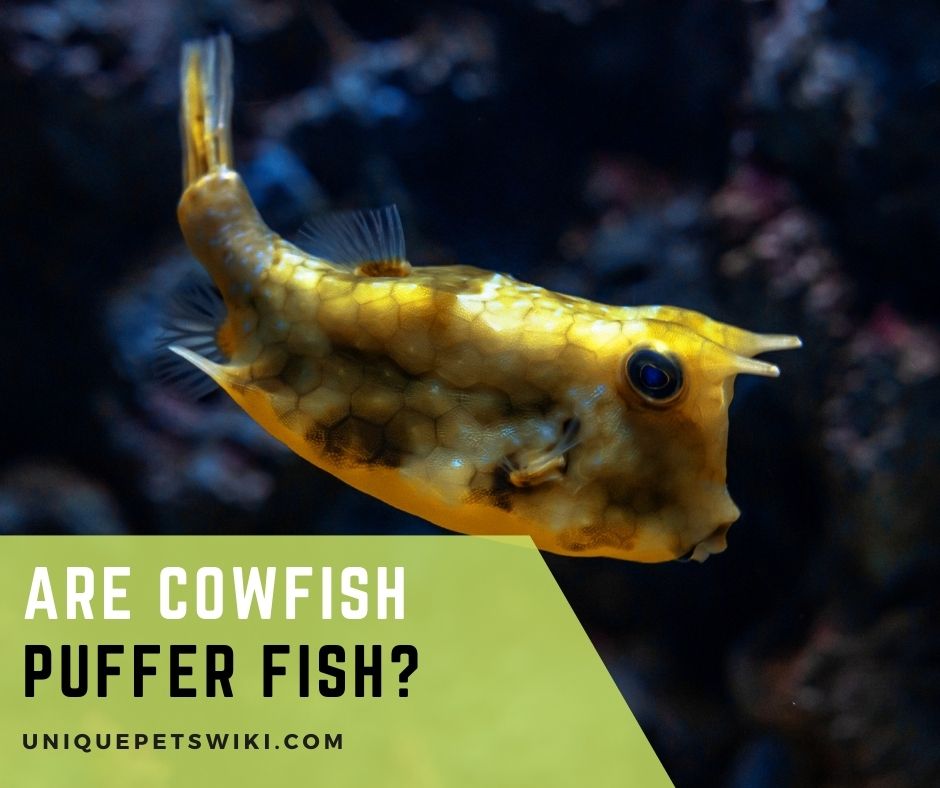So, what are cowfish anyway? We all know that the pufferfish is one of the most dangerous fish globally, but is a cowfish a type of pufferfish? Let’s find out!
You might be confused or curious if cowfish are related to pufferfish because of some similarities between the two fishes: such as its deadly defense mechanism because of toxicity.
Continue reading, and you’ll learn if cowfish are pufferfish. We’ll also give some information about the differences between cowfish and pufferfish and the similarities they might have.
Contents
Are Cowfish Puffer Fish?
No, cowfish are not pufferfish, though they are closely related. Cowfish and pufferfish are cousins.
Cowfish is a type of boxfish, and as you can probably tell from the name, cowfish are uniquely box-shaped and have a set of horns protruding from their head that you can’t miss.

Differences Between Cowfish and Puffer Fish
Although cowfish and pufferfish are closely related, distinct differences exist between the two fishes. We’ll talk about how they differ in physical features, defense mechanisms, and toxicity.
Physical Features
We can see the difference between a cowfish and a pufferfish just from their appearance alone.
A pufferfish has a round body known to inflate by assimilating water or air to be several times bigger than its normal size when some threats or predators might harm or eat them.
Some species of pufferfish have wild markings and colors to serve as a warning for their high toxicity, while there are others with colors that make them blend well in their surroundings.
Pufferfish don’t have scales, but they have rough or spiky skins that are highly poisonous, which many fishes avoid.
On the other hand, cowfish belong to the boxfish family, and the cowfish’s body is enclosed in a bony carapace or hard shell that is box-shaped with its fins, gills, mouth, and eyes sticking out.
They typically have a bright yellow color, but other species could be an array of colors.
Its distinct feature aside from its shape is its protruding set of horns on its head. It prevents predators from swallowing them whole; however, it is no use for larger fishes, and they will still get eaten.

Defense Mechanism
When faced with a predator, a pufferfish inflates by gulping down huge amounts of water or air, making themselves several times bigger than their normal size.
The increase in size intimidates the predators and prevents the pufferfish from being eaten.
Aside from the incredible inflation, their rough skin or spikes are also poisonous, which will kill the predators that will try to eat them. Aside from sharks, the pufferfish only have a few predators because of its toxicity.
On the other hand, the cowfish have a protective shell which aids them in avoiding being eaten by some predators. However, the hard shell makes them slow and gives them difficulty escaping larger fish.
When threatened or stressed, cowfish discharge a slimy, highly toxic mucus through their skin, spreading into the water and killing predators.
The cowfish also have a set of horns protruding from their head which prevents some predators from swallowing them whole. However, this does not stop larger fishes from eating them.
Toxicity
The toxin from a pufferfish, which is the tetrodotoxin, is fatal to both fishes and humans. Tetrodotoxin is a thousand times more poisonous than cyanide. The poison from a single pufferfish can kill 30 humans.
The pufferfish have rough skin or spikes that have deadly toxins. Even if the pufferfish is not covered in spikes, the poison of a pufferfish is in its liver, gonads (ovaries and testes), intestines, and skin.
So, consuming them is just as deadly as getting pricked by their spikes.
A pufferfish is highly fatal when ingested. Despite the danger, it is considered a delicacy in some countries such as Japan.
However, only trained and licensed chefs can prepare and serve this delicacy, as preparing this dish requires utmost precision and care for it to be safe for consumption.
On the other hand, cowfish are also very poisonous creatures. A cowfish secretes a fatal, slimy, soap-like mucous through their skin, containing a deadly toxin: pahutoxin, formerly known as ostracitoxin.
Contrary to the lethality of pufferfish toxin to humans, eating a cowfish is not as dangerous as long as it is cooked well. In some parts of the world, cowfish are also considered a delicacy.
Caution is still needed, along with the consumption of cowfish. While it is not fatal to humans, it could still be harmful because of its toxins when ingested.
However, it is fatal to fish because if a cowfish are scared or threatened, the secreted toxin will spread in the water and kill everything in its vicinity.
Can a Cow Fish and Puffer Fish Live Together?
No, a cowfish and a pufferfish cannot live together as they are both poisonous creatures. Some species of cowfish are dangerous to other fish, and also themselves, in an aquarium.
If they are threatened or become overly stressed, they will exude a toxic substance that will kill everything in the aquarium.
So, putting a cowfish and a pufferfish is a bad idea as the cowfish might get scared or stressed because of the pufferfish. The cowfish will secrete a deadly substance into the tank, killing the pufferfish and itself.
However, the tank could be big enough to lessen interactions between the two fishes. But in terms of food, the cowfish will be at a disadvantage because of its slow movements.
Because of the cowfish’s hard, heavy, and boxy shell, it has difficulty swimming and hunting for food.
So, if a pufferfish is together with a cowfish, it will get a hold of all the food, leaving nothing to the cowfish, which will lead the cowfish to starvation.
Wrapping Up
To wrap it up, cowfish is not a pufferfish because cowfish is a type of boxfish.
The difference between the two is apparent in their physical features; cowfish have a hard, protective shell and are box-shaped, while pufferfish is round-shaped and have rough or spiky skin.
Both fishes are highly poisonous creatures that kill their predators. Their toxins are fatal to fish. However, a cowfish is not lethal to humans compared to pufferfish.
Some countries have cowfish and pufferfish as delicacies despite the danger of consuming these toxins.
